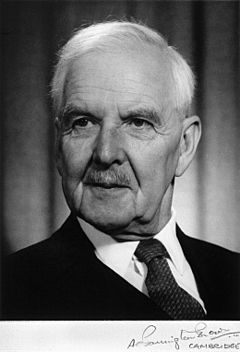Rudolph Peters facts for kids
Quick facts for kids
Sir Rudolph Albert Peters
|
|
|---|---|
 |
|
| Born | 13 April 1889 |
| Died | 29 January 1982 (aged 92) |
| Nationality | British |
| Spouse(s) | Frances Williamina Vérel |
| Awards | FRS (1935) Royal Medal (1949) Cameron Prize for Therapeutics of the University of Edinburgh (1950) |
Sir Rudolph Albert Peters (born April 13, 1889 – died January 29, 1982) was a very important British scientist. He was a biochemist, which means he studied the chemical processes happening inside living things.
Sir Rudolph is best known for leading a team at Oxford University that created British Anti-Lewisite (BAL). This was a special medicine used as an antidote for lewisite, a dangerous chemical weapon. His work was super important during wartime to help soldiers.
Contents
Early Life and Education
Rudolph Albert Peters was born in Kensington, a part of London, on April 13, 1889. His father, Dr. Albert E. D. R. Peters, was also a doctor.
He went to school at Wellington College, Berkshire. Later, he studied medicine at King's College London and Gonville and Caius College, Cambridge.
War Service and Research
During the First World War, Sir Rudolph served as a medical officer. He worked with the Royal Army Medical Corps. From 1917, he joined a special team at Porton Down that focused on chemical warfare.
His research into how arsenic war gases worked was very important. It helped keep soldiers safe and effective on the battlefield.
Academic Career
After the First World War, Sir Rudolph went back to Cambridge University. He taught biochemistry there. In 1923, he became a Professor of Biochemistry at Oxford University.
After the Second World War, he continued his important research. He studied how the body uses a substance called pyruvate. He also looked into how a chemical called fluoroacetate could be poisonous.
He discovered that fluoroacetate itself wasn't as harmful as what it turned into inside the body. This led him to create the idea of "lethal synthesis". This means that a substance might not be harmful on its own, but it becomes deadly when the body changes it.
Later Life and Honors
Sir Rudolph retired from his university job in 1954. Even at 65 years old, he started a new biochemistry department. This was at the Agricultural Research Council Animal Physiology Unit in Babraham. He worked there for five more years before fully retiring.
He received many honors for his amazing work. In 1935, he became a FRS, which is a very high honor for scientists. Queen Elizabeth II made him a knight in 1952, so he became "Sir" Rudolph.
Sir Rudolph Albert Peters passed away in Cambridge on January 29, 1982.
Family Life
Sir Rudolph married Frances Williamina Vérel on November 7, 1917. They had two sons together: Rudolph V and Francis Raymond.

